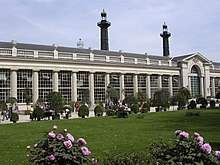Orangery
**Historical Development and Significance:**
– Orangeries date back to the 16th century in Padua, Italy.
– John Parkinson introduced orangeries in England in 1628.
– Orangeries were practical structures with open fires for heating initially.
– Orangeries were popular in France, Germany, and the Netherlands in the 17th century.
– Dutch advancements in glass-making influenced orangery design.
**Construction and Architecture:**
– Orangeries were typically built facing south for maximum sunlight.
– Brick or stone bases and pillars were common in orangery construction.
– Large windows were used to maximize sunlight.
– Insulation was a key concern, often using straw and wooden shutters.
– Orangeries were symbols of prestige and wealth.
**Early Orangeries and Features:**
– Noblemen and wealthy merchants cultivated citrus plants in orangeries.
– Demand for exotic plants fueled the popularity of orangeries.
– Techniques like underfloor heating and roof ventilation were introduced for plant propagation.
– Orangeries were considered garden features like summerhouses or temples.
– Owners used orangeries to showcase fruits and entertain guests.
**Orangeries in Different Regions:**
– Orangeries were part of garden tours and featured fountains and grottos.
– The Versailles Orangerie was one of the largest and most famous orangeries.
– Historic Orangeries in the UK include Kensington Palace and Royal Botanic Gardens, Kew.
– Orangeries in the United States include Mount Vernon Orangery and Dumbarton Oaks estate orangery.
– Notable 18th and 19th-century orangeries in the US are found at various historic sites.
**Modern Orangeries and Adaptations:**
– Modern orangeries use stone, brick, hardwood, and advanced insulation materials.
– Glazed roofs in orangeries became popular in the 19th century.
– Orangeries were not just greenhouses but also served as garden features.
– Tower Hill Botanic Garden orangery in Boylston, Massachusetts, was built in the 1980s.
– Authors like Mary Woods and Clara H. Hasse have contributed to the study of orangeries.
An orangery or orangerie is a room or dedicated building, historically where orange and other fruit trees are protected during the winter, as a large form of greenhouse or conservatory. In the modern day an orangery could refer to either a conservatory or greenhouse built to house fruit trees, or a conservatory or greenhouse meant for another purpose.




The orangery provided a luxurious extension of the normal range and season of woody plants, extending the protection which had long been afforded by the warmth offered from a masonry fruit wall. During the 17th century, fruits like orange, pomegranate, and bananas arrived in huge quantities to European ports. Since these plants were not adapted to the harsh European winters, orangeries were invented to protect and sustain them. The high cost of glass made orangeries a status symbol showing wealth and luxury. Gradually, due to technological advancements, orangeries became more of a classic architectural structure that enhanced the beauty of an estate garden, rather than a room used for wintering plants.
The orangery originated from the Renaissance gardens of Italy, when glass-making technology enabled sufficient expanses of clear glass to be produced. In the north, the Dutch led the way in developing expanses of window glass in orangeries, although the engravings illustrating Dutch manuals showed solid roofs, whether beamed or vaulted, and in providing stove heat rather than open fires. This soon created a situation where orangeries became symbols of status among the wealthy. The glazed roof, which afforded sunlight to plants that were not dormant, was a development of the early 19th century. The orangery at Dyrham Park, Gloucestershire, which had been provided with a slate roof as originally built about 1702, was given a glazed one about a hundred years later, after Humphrey Repton remarked that it was dark; although it was built to shelter oranges, it has always simply been called the "greenhouse" in modern times.
The 1617 Orangerie (now Musée de l'Orangerie) at the Palace of the Louvre inspired imitations that culminated in Europe's largest orangery, the Versailles Orangerie. Designed by Jules Hardouin-Mansart for Louis XIV's 3,000 orange trees at Versailles, its dimensions of 508 by 42 feet (155 by 13 m) were not eclipsed until the development of the modern greenhouse in the 1840s, and were quickly overshadowed by the glass architecture of Joseph Paxton, the designer of the 1851 Crystal Palace. His "great conservatory" at Chatsworth House was an orangery and glass house of monumental proportions.[citation needed]
The orangery, however, was not just a greenhouse but a symbol of prestige and wealth and a garden feature, in the same way as a summerhouse, folly, or "Grecian temple". Owners would conduct their guests there on tours of the garden to admire not only the fruits within but also the architecture outside. Often the orangery would contain fountains, grottos, and an area in which to entertain in inclement weather.[citation needed]
